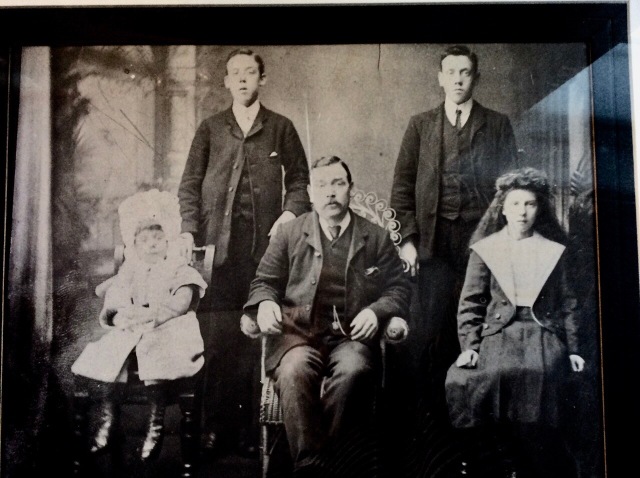
It is, after all, only one day…
Have you ever re-assembled a day into a different sequence? Been so involved with its contents that the threads seem to weave themselves, again… and differently.
But it is only one day… and at the halfway point she will be waiting; waiting near the red tower where we will meet for the first time. And then the torn thread of ninety-seven years will be re-woven… for real, not just as a story.
It’s early October, 2017. It’s also AD 440 on a rocky cliff top towards which we are walking; and it’s 1914, and a picture from my genetic past rises, again, in my consciousness and returns to haunt me…

She’s very young, the girl in the black and white family photo. Her feet don’t touch the floor on the adult chair, and she stands out as much younger than the rest of them. She is my paternal grandmother, and her name is Elizabeth.
We know the island of Anglesey quite well. Even from Cumbria, it’s a relatively easy journey, courtesy of the northern M6 and the A55 dual-carriageway that follows the North Wales coast right to the bridges over the beautiful Menai Straits.
We’re having a short break near Cemaes Bay, which is located in the north of this historic and fascinating island.
My annotated Anglesey photo (above) from the tourist board at the tiny seaside village of Camaes Bay shows the location of this beautiful stretch of coast, which boasts that it is ‘the most northerly village in Wales’.

We had planned our trip carefully. It was to be a day of two halves, with very different agendas. The lunchtime and afternoon were to be spent on the reuniting of two family threads that have been separated by a near-hundred year gap, about which more later…
The morning was ours to fill, and we had our eyes on the nearby clifftop church of St Patrick’s; a place we had read about but never visited.

The beautiful bay of Cemaes is well known. Less celebrated is the ancient tiny church on the adjacent headland of Llanbadrig, and its founding by no less a figure than St Patrick, the father of the first Christian communities in Ireland and the west coast of Scotland

According to local legend, in AD 440, Bishop Patrick, as he was then, was on his maiden voyage from St Columba, on Iona, to Ireland, in order to bring it into line with Christianity – empowered by holy orders from Pope Celestine.
As often happens with the Patrick of legends, his voyage was ravaged by storms. The ship was driven towards the brutal coastline by the notorious Anglesey winds and shipwrecked onto the rock of Middle Mouse – now called St Patrick’s island, where he was marooned.

Above: the tiny rock of St Patrick’s Island, formerly Middle Mouse.
He clings to the rock that, later, he will find is called Middle Mouse, though they will rename it. His coarse robe has taken on so much water that it’s seen him nearly drowned. Only by tearing at it was he able to squeeze between the jagged, black rocks that held him captive, while the breakers pounded him to a bloody mess. But he’s alive… nearly naked, frozen, bleeding and weeping. But alive… In the boiling sea, splinters of wood flicker into focus as he scans the waves for signs of they who brought him here, steered a course from Iona until the waves turned to salty mountains risen from the blackest nightmare.
But alive…
The photograph is taken; the photographer is thanked and dismissed. The members of the family – minus mother, Maria, who believes that cameras steal your souls – leave the family room. But not all of them… Stephen gazes down at his youngest sister, tears forming in his eyes. How difficult it is to know he will see her, again. She will not turn to look at him. She knows that the most precious person in her world is leaving. He is going to war; he and his fine engineer’s mind and his self-taught and fluent French.
(Continued in Part Two)
———
Stephen Tanham is a director of the Silent Eye School of Consciousness, a not-for-profit organisation that helps people find the reality and essence of their existence via low-cost, supervised correspondence courses.His personal blog, Sun in Gemini, is at stevetanham.wordpress.com
©️Stephen Tanham

Reblogged this on anita dawes and jaye marie.
Thank you, Sue x
🙂
Oh tears forming here too
It’s a wonderful story – sad in parts but with a wonderful ending. And it’s all true!
I have never heard that people thought cameras stole their souls. Fascinating. You know that the opening photo of the two fingers is sign language for “friend”. Thank you for such an interesting post.
It was a common belief among cultures that encountered cameras for the first time, Jennie. My great grandmother subscribed to it, too! There are three parts to the story.
Thank you, Steve. And, I look forward to the next parts.